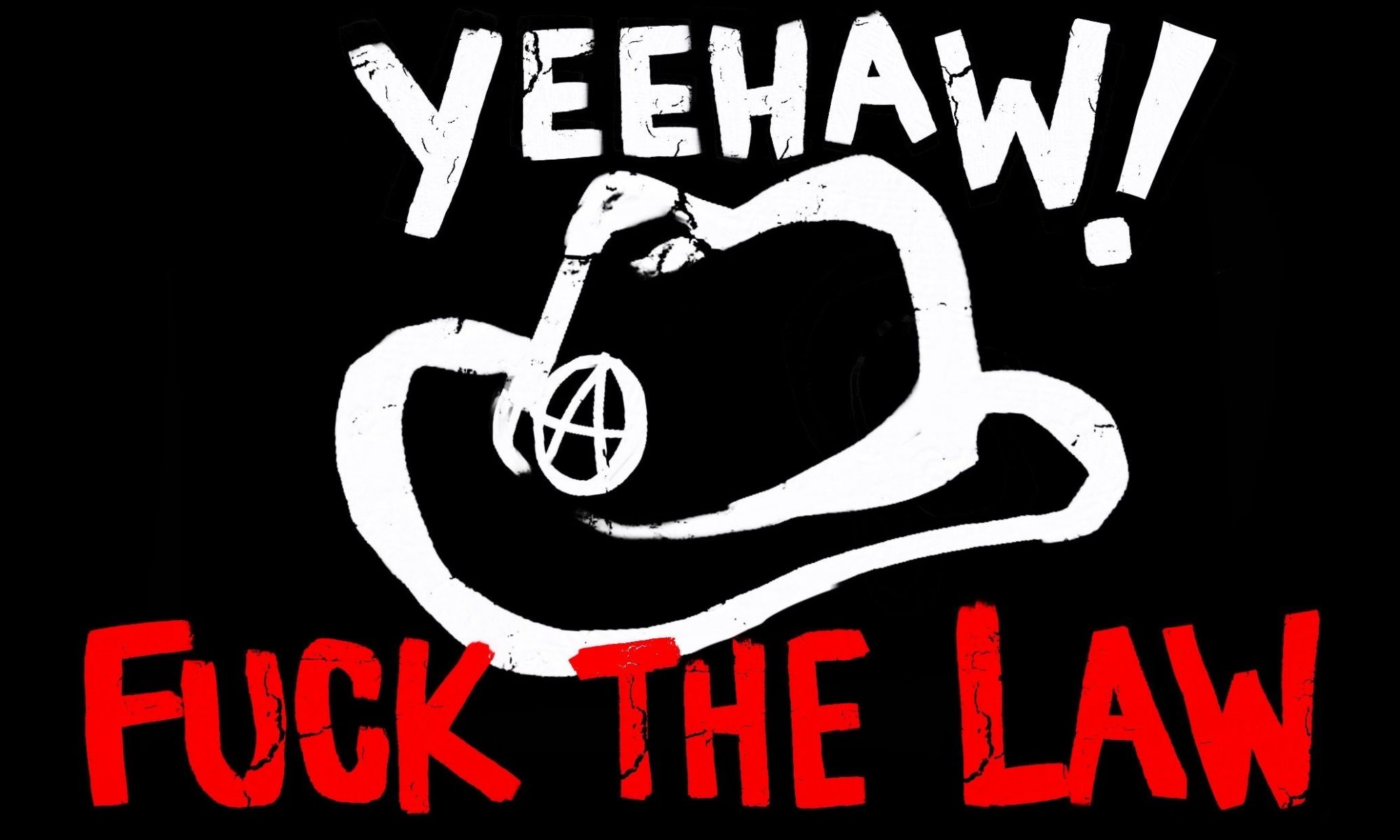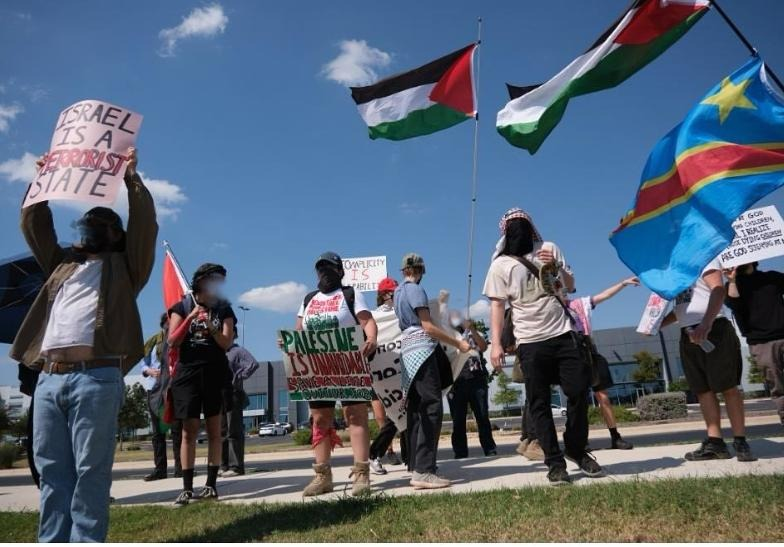An anonymous transmission
On 10/7, the anniversary of the heroic Al-Aqsa Flood operation launched by the unified Palestinian resistance factions, a group of 30 people demonstrated at the BAE facility in Austin. The BAE office sits in a corporate park that also houses General Motors, 3M, Qualcomm, Infosys, Apple, and other tech companies. This corporate park was labelled the “Core of Genocide in Austin” as indicated by a banner at the demo.
The rally started off fairly tame and hesitant. Many were uncertain what the police response would be; the rally had been pre-announced on social media, and the last deviation from the downtown parade spectacle (the encampments) resulted in heavy repression with mass arrests and injury. For the first hour or so, the rally stood on the side of the road facing Parmer, chanted, and received honks from supportive passerby. The rally was only observed from the parking lot by a small handful of private security guards. No cops were present.
After tiring of standing and chanting, the demo turned into a march. The crowd walked down the sidewalks past the BAE building, chanting and yelling in its direction. As the crowd turned towards a road leading towards a private entrance, the energy started to build. The crowd walked up towards the parking lot, where they were cut off by a security guard in his car who unenthusiastically asked the group not to come up onto private property, but encouraged the group to be on the sidewalks. After a brief yelling match, the crowd marched back towards the sidewalk near the front entrance.
There, after spending another few minutes chanting and yelling at gawking BAE employees, the rally found another round of courage and marched up to the door of the facility. Despite the frustrated threats of another security guard, who claimed they were calling the cops, the rally stood its ground outside the facility. After about 15 minutes, with no sign of police response, the group returned to the sidewalk to recharge. After a brief break, they marched through the corporate park towards Apple, then ended shortly after.
While the action in itself was only mildly confrontational or escalatory in intensity, the gesture of this demo opens up a new front for the movement for Palestine locally. This is fitting for a gesture that honors the Al-Aqsa Flood battle. By identifying the “Core of Genocide,” this action challenges the movement to refocus its priorities, and demonstrated that it is easier and more effective to target this area. Even the simple activity of marching and chanting–not that different from the content of rallies downtown–feels more meaningful here, as one can direct their rage directly at the workers & infrastructure complicit in the genocide, rather than an empty legislature or the glass walls of a hi-rise.
The police are far less likely, less prepared, and less capable of mobilizing in massive force here–whereas they have extensive training and infrastructure for overpolicing the downtown & campus playground. The area around the tech campus is a mixture of lower-income suburban neighborhood, brush and trails, apartments, and businesses, with lots of spaces for people to gather, park, disperse, or move around. A wide range of autonomous actions could be experimented with here–pickets, office disruptions, autonomous art initiatives, and even classic rallies. If even a fraction of the crowds that are mobilized for rallies downtown could be mobilized to this campus, it would open new opportunities for the movement. More of the movement should turn its attention to this new front, and consider what they have the capability to plan advance the struggle here.
The opening of a new front, one that escalates in direct confrontation with the war machine, is essential to the growth and survival of the movement for Palestine locally. Locally and nationally, energy and turnout for rallies has waned. The futility of the existing routine of managed protest has become more palpable and more draining, particularly in the wake of a year of genocide and the post-encampment movement lull. Across the continent, everyone is seeking new directions for the movement to stop the genocide.
It is hard to say what direction the movement must go, to know what actions and trajectories will accomplish the task before us. The existing strategies in the activist toolkit will find limited purchase. The Amerikkkan economic & geopolitical interests lined up behind Israel are too invested to be swayed by any combination of demonstrations voicing our opposition, or by pressure campaigns trying to convince military contractors to end their business model and abolish themselves. As the brutality of the spring should have made clear, the facade of democratic order and liberal rights fall away when the core of the colonial project is threatened. Probably, any real challenge to the genocide would require a high degree of unrest to generalize across the country, undermining the government’s ability to rule, the functioning of the economy, and the stability of the military.
This is a tall order for a Left that can barely get beyond navel-gazing about its own powerlessness and victimization, or that capitulates to the State and polices itself. But we can start by finding our next step forward–the next action or direction that can build the size, militancy, and effectiveness of the movement. The turn towards the Tech Core of Genocide is one such direction. An escalation of disruptive activity targeted at the role that Austin-based tech plays in the genocide holds the potential to re-energize those who have been drained by the endless parades down Congress and inagurate a new cycle of varied movement activities in a new area. Such an escalation sets the stage for a real confrontation and challenge to the most important local ties to the genocide. This also forces the local movement into a confrontation with the economic forces that dominate the city and its economic interests–themselves aligned with a domestic project of displacement, development, and dispossession.
Perhaps there are better focus points for escalation in Austin. Or perhaps the most powerful contribution the movement in Austin can make is mobilizing forces *somewhere else*, somewhere more materially impactful on halting the war machine or generalizing social unrest. Or, perhaps, a few relatively simple but powerful actions at BAE could set the stage for a new explosion of activity locally, and perhaps regionally or nationally. The answer can only be found through experimentation, strategic thought, and reflection–qualities the movement has thus far been lacking, particularly the last two.
A brief recap of the rally was posted to Instagram. While it is good to post even brief summaries of our activities, and to engage traditional social media to do so, we challenge autonomous forces in the movement to advance beyond this. We challenge the movement to generate and circulate their own strategic reflections on their activity, the opportunities and limitations they perceive, and proposals for others to take up. Particularly, we encourage the movement to do so in ways not determined by the logics of the social media platforms we use, and should make our movements less reliant on these platforms alone. This could look like more long form texts to go to counterinfo sites like It’s Going Down or Austin Autonomedia (though you could easily start your own), or circulate on large Signal threads. It will mean fewer Instagram infographics, which pushed towards analytically shallow, attention grabbing, highly aestheticized content. Our reflections, analysis, and reportbacks should not be structured to fit the limitations of an Instagram slide deck; we should build Instagram slide decks to highlight and circulate our deeper reflections and analysis, which ought to be developed outside of social media, ideally in direct conversations and meetings with other comrades in the movement.
Long Live the Resistance, Long Live Al-Aqsa Flood!
–some reflective protesters
Got a something you need to publish? Send it to us! We take all kinds of radical/revolutionary content, with a special affinity for anarchist/autonomous movements and crews. We specialize in research and strategic intelligence that can inform direct action, but we’ll take art, opinion pieces, and other stuff too! Submit content to austinautonomedia [@] autistici [dot] org. You can also subscribe to our mailing list to get direct updates about new content

